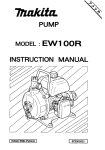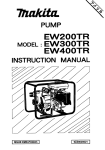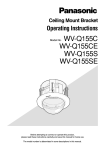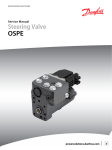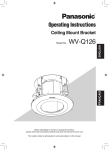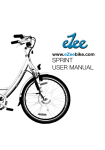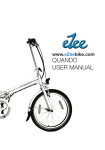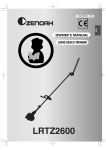Download RedMax GZ25N Specifications
Transcript
Golden Eagle Bike Engines P.O. Box 365 East Lansing, MI 48826 OWNER/OPERATOR MANUAL _ WARNINGS IN THE MANUAL This mark indicates instructions which must be followed in order to prevent accidents which could lead to serious bodily injury or death. • SAFETY FIRST This mark indicates instructions which must be followed, or it leads to mechanical failure, breakdown, or damage. Instructions contained in warnings within this manual marked with a symbol concern critical points which must be taken into consideration to prevent possible serious bodily injury, and for this reason you are requested to read all such instructions carefully and follow them without fail. This mark indicates hints or directions useful in the use of the product. Table of Contents Page 2 Page 3 Page 3 & 4 Page 4 Page 5 & 6 Page 6& 7 Page 8, 9 & 10 page 11 Page 11 Specifications Symbols on the machine For safe operation Set up Fuel Operation Maintenance Storage Troubleshooting guide Specifications 11.7 lbs (5.3kg) Air-cooled 2-stroke gasoline Zenoah GZ25N 1.6cu-in (25.4cc) 1.2Hp (0.9kW)at 7500/min (rpm) 3000–200/min (rpm) Mixture(Gasoline 50 : Oil 1) Walbro Diaphragm type NGK CMR7A 22.0 fl.oz (0.65 ) Dry weight with accessories Engine Type Model Displacement Max. output Idle speed Fuel Carburetor Spark plug Fuel tank capacity -1 -1 2 For safe operation and maintenance, symbols are carved in relief on the machine. According to these indications, please be careful not to take a mistake. Never modify your engine/mount. We won’t warrant the machine, if you don’t observe the proper usage written in the manual. (a) The port to refuel the "MIX GASOLINE" Position: FUEL TANK CAP Symbols on the Machine (b) The direction to close the choke Position: AIR CLEANER COVER (c) The direction to open the choke Position: AIR CLEANER COVER possibility exists that your judgment might be impaired or that you might not be able to operate the product properly and in a safe manner. 7. Keep all parts of your body away from hot surfaces. 8. Never touch the muffler, spark plug, or other metallic parts of the engine while the engine is in operation or immediately after shutting down the engine. Doing so could result in serious burns or electrical shock. 1. Read this manual carefully until you completely understand and follow all safety and operating instructions. 2. Keep this manual handy so that you may refer to it later whenever any questions arise. Also note, if you have any questions which cannot be answered herein, contact G.E.B.E. from whom you purchased the product. 3. Always be sure to include this manual when selling, lending, or otherwise transferring the ownership of this product. 4. Never allow children or anyone unable to fully understand the directions given in the manual to use the machine. 5. Never start the engine inside a closed room or building. Exhaust gases contain dangerous carbon monoxide. 6. You should never use the product when under the influence of alcohol, when suffering from exhaustion or lack of sleep, when suffering from drowsiness as a result of having taken cold medicine or at any other time when a _ MAINTENANCE 1. In order to maintain your product in proper working order, perform the maintenance and checking operations described in the manual at regular intervals. 2. Always be sure to turn off the engine before performing any 3 maintenance procedures. or repair work not described in this manual must be performed, contact a G.E.B.E. representative. 5. Under no circumstances should you ever take apart the product or alter it in any way. Doing so might result in the product becoming damaged during operation or the product becoming unable to operate properly. checking The metallic parts reach high temperatures immediately after stopping the engine. 3. When replacing the oil or any lubricant, always be sure to u s e o n l y RedMax products or products which have been certified by RedMax for use with the RedMax product. 4. In the event that any part must be replaced or any maintenance or rough roads over long distances by vehicle without removing all fuel from the fuel tank. If doing so, fuel might leak from the tank during transport. _ HANDLING FUEL 1. The engine of the RedMax product is designed to run on a mixed fuel which contains highly flammable gasoline. Never store cans of fuel or refill the tank of the unit in any place where there is a boiler, stove, wood fire, electrical sparks, welding sparks, or any other source of heat or fire which might ignite the fuel. 2. Never smoke while operating the unit or refilling its fuel tank. 3. When refilling the tank, always turn off the engine and allow it to cool down. Take a careful look around to make sure that there are no sparks or open flames anywhere nearby before refueling. _ CONNECTING THROTTLE WIRE 1. Remove the air cleaner cover. 2. Connect the end of the throttle wire to the joint on the top of the carburetor. (SE7) _ CONNECTING SWITCH WIRES • Connect the switch wires between the engine and mount. Connect the wires: Black to Yellow and Red to Green . (SE7) 4. Wipe spilled fuel completely using a dry rag if any fuel spillage occurs during refueling. 5. After refueling, screw the fuel cap back tightly onto the fuel. _ TRANSPORTATION • Never transport the product over 4 Fuel • • Gasoline is very flammable. Avoid smoking or bringing any flame or sparks near fuel. Make sure to stop the engine and allow it cool before refueling the unit The RedMax engines are lubricated by oil specially formulated for aircooled 2-cycle gasoline engine use. If RedMax oil is not available, use an anti-oxidant added quality oil expressly labeled for air-cooled 2cycle engine use. (JASO FC GRADE OIL or ISO EGC GRADE) RECOMMENDED MIXING RATIO GASOLINE 50:OIL 1 • 50:1 MIXING CHART GASOLINE gal. 2-CYCLE OIL fl. oz. GASOLINE liter 2-CYCLE OIL ml 1 2 3 4 5 2.6 5.2 7.8 10.4 13 1 2 3 4 5 20 40 60 80 100 • • • • 5 Exhaust emission are controlled by the fundamental engine parameters and components (eq., carburation, ignition timing and port timing) without addition of any major hardware or the introduction of an inert material during combustion. These engines are certified to operate on unleaded gasoline. Make sure to use gasoline with a minimum octane number of 90 ROZ(USA/Canada : pump octane min.87) Unleaded gasoline is recommended to reduce the contamination of the air for the sake of your health and the environment. Poor quality gasolines or oils may damage sealing rings, fuel lines or fuel tank of the engine. Fuel _ HOW TO MIX FUEL 1. Measure out the quantities of gasoline and oil to be mixed. 2. Put some of the gasoline into a clean, approved fuel container. 3. Pour in all of the oil and agitate well. 4. Pour in the rest of gasoline and agitate again for at least one minute. 5. Put a clear indication on the outside of the container to avoid mixing up with gasoline or other containers. 6. Indicate the contents on outside of container for easy identification. FOR YOUR ENGINE LIFE, AVOID; 1. FUEL WITH NO OIL(RAW GASOLINE) — It will cause severe damage to the internal engine parts very quickly. 2. GASOHOL — It can cause deterioration of rubber and/or plastic parts and disruption of engine lubrication. 3. OIL FOR 4-CYCLE ENGINE USE or WATER COOLED 2-CYCLE ENGINE USE — It can cause spark plug fouling, exhaust port blocking, or piston ring sticking. 4. Mixed fuels which have been left unused for a period of one month or more may clog the carburetor and result in the engine failing to operate properly. _ FUELING THE UNIT 1. Untwist and remove the fuel cap. Rest the cap on a dustless place. 2. Put fuel into the fuel tank. 3. Fasten the fuel cap securely and wipe up any fuel spillage around the unit. Operation Starting the Engine (1) Choke lever (2) On (3) Off 1. Push the primer pump several times until overflown fuel flows out in the clear tube. (OP1) 2. Move the choke lever to the ON position. (OP2) 3. Pull out the starter rope quickly until engine fires. 6 Operation • • • Avoid pulling the rope to its end or returning it by releasing the knob. Such actions can cause starter failures. Move the choke lever to the OFF position and restart the engine (OP2) Allow engine to warm up for several minutes. 1. When restarting the engine immediately after stopping it, leave the choke in the off position. 2. Over choking can make the engine hard to start due to excess fuel. _ ADJUSTING THROTTLE CABLE (OP5) • The normal play is 1 or 2mm when measured at the carburetor side end. Readjust with the cable adjuster as required. (OP5) (1) cable adjuster _ ADJUSTING IDLING SPEED (OP6) • When the engine tends stop frequently at idling mode, turn the adjusting screw clockwise. (1) idle adjusting screw • 7 Warm up the engine adjusting the idling speed. before Maintenance _ MAINTENANCE CHART System/Component fuel leaks, fuel spillage fuel tank, air filter, fuel filter spark plug cylinder fins, intake air cooling vent muffler, spark arrester, cylinder exhaust port Procedure Every 25 hours after Before use wipe out ✓ inspect/clean ✓ Every 50 hours after Every 100 hours after ✓ clean and readjust plug gap ✓ Note replace, if necessary GAP: .025in(0.6~0.7mm) replace, if necessary ✓ clean ✓ clean Make sure that the engine has stopped and is cool before performing any 8 service to the machine. Contact with hot muffler may result in a personal injury. Maintenance _ AIR FILTER • The air filter, if clogged, will reduce the engine performance. Check and clean the filter element in warm, soapy water as required. Dry completely before installing. If the element is broken or shrunk, replace with a new one. (MA5) (1) air filter • • _ FUEL FILTER • When the engine runs short of fuel supply, check the fuel cap and the fuel filter for blockage. (MA6) (1) fuel filter _ SPARK PLUG • Starting failure and mis-firing are often caused by a fouled spark plug. Clean the spark plug and check that the plug gap is in the correct range. For a replacement plug, use the correct type specified by RedMax. (MA7) • REPLACEMENT PLUG IS A NGK CMR7A. • Note that using any spark plug other than those designated may result in the engine failing to operate properly or in the engine becoming overheated and damaged, and void your warranty. • To install the spark plug, first turn the plug until it is finger tight, then tighten it a quarter turn more with a socket wrench. TIGTENING TORQUE: Inspect periodically, the muffler for loose fasteners, any damage or corrosion. If any sign of exhaust leakage is found, stop using the machine and have it repaired immediately. Note that failing to do so may result in the engine catching on fire. _ SPARK ARRESTER • The muffler is equipped with a spark arrester to prevent red hot carbon from flying out of the exhaust outlet. Periodically inspect and clean as necessary with a wire brush. Using needle nose pliers, pull spark arrester to remove, push to reinstall after cleaning. In the State of California it is required by law (Section 4442 of the California Public Resources Code) to equip a spark arrester when a gas powered tool is used in any forest covered, brush covered, or grass covered unimproved land. (MA8) (1) spark arrester 87~104 in-lbs (9.8~11.8 N.m.) 9 Maintenance • _ INTAKE AIR COOLING VENT • • • Never touch the cylinder, muffler, or spark plugs with your bare hands immediately after stopping the engine. The engine can become very hot when in operation, and doing so could result in severe burns. When checking the machine to make sure that it is okay before using it, check the area around the muffler and remove any debris. Failing to do so could cause the muffler to become overheated, and that this in turn could cause the engine to catch on fire. Always make sure that the muffler is clean and free of debris. Check the intake air cooling vent and the area around the cylinder cooling fins after every 25 hours of use for blockage, and remove any waste which has attached itself. Note that it is necessary to remove the engine cover shown in (MA10) in order to be able to view the upper part of the cylinder. If waste gets stuck and causes blockage around the intake air cooling vent or between the cylinder fins, it may cause the engine to overheat, and that in turn may cause mechanical failure. (MA10) (1) cylinder (2) intake air cooling vent (back) _ (MA11) PROCEDURES TO BE PERFORMED AFTER EVERY 100 HOURS OF USE 1. Remove the muffler, insert a screwdriver into the vent, and wipe away any carbon buildup. Wipe away any carbon buildup on the muffler exhaust vent and cylinder exhaust port at the same time. 2. Tighten all screws, bolts, and fittings. 3. Check to see if any oil or grease has worked its way in between the clutch lining and drum, and if it has wipe it away using oil-free, lead-free gasoline. 10 Storage Aged fuel is one of major causes of engine starting failure. Before storing the unit, empty the fuel tank and run the engine until it uses all the fuel left in the fuel line and the carburetor. Store the unit indoor taking necessary measures for rust prevention. Trouble Shooting Guide Case 1. Starting failure CHECK fuel tank fuel filter carburetor adjustment screw sparking (no spark) PROBABLE CAUSES incorrect fuel fuel filter is clogged out of normal range is fouled/wet plug gap is incorrect spark plug disconnected ACTION drain and fill with correct fuel clean adjust to normal range clean/dry correct (GAP: 0.6~0.7mm) spark plug retighten Case 2. Engine starts but does not keep running/Hard re-starting. CHECK PROBABLE CAUSES ACTION fuel tank incorrect fuel or staled fuel drain and fill with correct fuel carburetor adjustment screw out of normal range adjust to normal range muffler, cylinder (exhaust port) carbon is built-up wipe away air cleaner clogged with dust wash cylinder fin, fan cover clogged with dust clean When your unit seems to need further service, please consult with the G.E.B.E. 11











